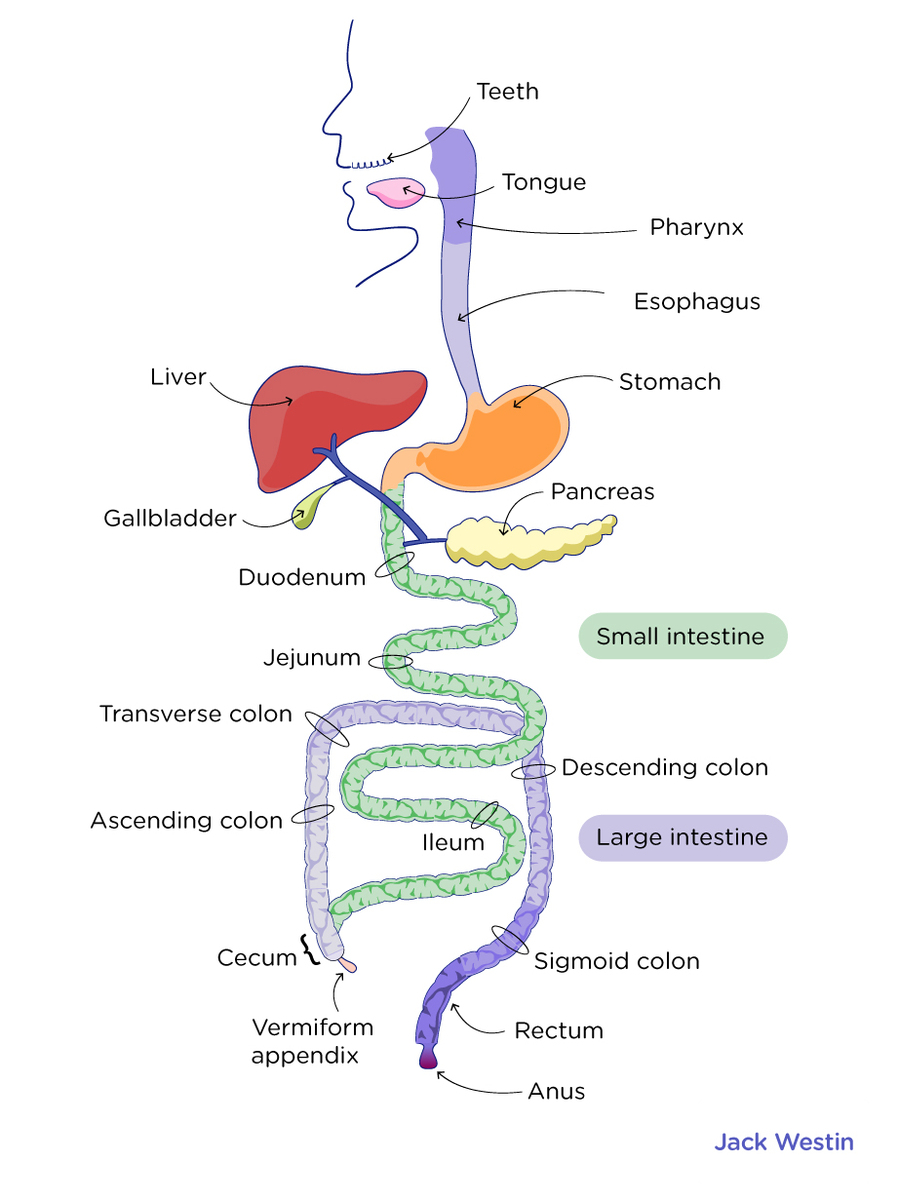The large intestine is a large tube-like structure that absorbs water from the undigested food received from the small intestine. The large intestine contains bacterial flora. The parts of the large intestine are the cecum, ascending colon, transverse colon, descending colon, sigmoid colon and rectum.


The large intestine consists of the cecum and colon. It starts in the right iliac region of the pelvis, just at or below the right waist, where it is joined to the bottom end of the small intestine (cecum). From here it continues up the abdomen (ascending colon – 1), then across the width of the abdominal cavity (transverse colon – 2), and then it turns down (descending colon – 3), continuing to its endpoint at the anus (sigmoid colon to the rectum to anus – 4 ).
The large intestine differs in physical form from the small intestine in several ways. The large intestine is much wider, and instead of having the evaginations of the small intestine (villi), the large intestine has invaginations.
The main functions of the colon are to extract the water and mineral salts from undigested food and to store waste material. It also contains bacterial flora that produces some vitamins such as vitamin K. The large intestine does not contain villi and microvilli.
The large intestine houses over 700 species of bacteria that perform a wide variety of functions; it is the largest bacterial ecosystem in the human body. The large intestine absorbs some of the products formed by the bacteria that inhabit this region. For example, undigested polysaccharides (fiber) are metabolized to short-chain fatty acids by the bacteria in the large intestine and then are absorbed by passive diffusion. Also, the bicarbonate that the large intestine secretes helps to neutralize the increased acidity that results from the formation of these fatty acids.
Practice Questions
Khan Academy
MCAT Official Prep (AAMC)
Biology Question Pack, Vol 2. Passage 3 Question 14
Biology Question Pack, Vol 2. Passage 12 Question 76
Biology Question Pack, Vol 2. Passage 12 Question 78
Key Points
• The large intestine is a tube-like structure that absorbs water from undigested food particles.
• It also contains bacterial flora that produces vitamins such as vitamin K.
• Villi and microvilli are absent in the large intestine wall.
• It has three parts: the cecum, the colon, and the rectum. The colon has four subparts that are ascending colon, transverse colon, descending colon and sigmoid colon.
Key Terms
Colon: part of the large intestine; the final segment of the digestive system, after (distal to) the ileum and before (proximal to) the anus
Cecum: A pouch, usually peritoneal, that is considered to be the beginning of the large intestine.
Villi: small, finger-like projections that extend into the lumen of the small intestine
Invagination: consists of the folding of an area of the exterior sheet of cells towards the inside
Passive diffusion: The net movement of material from an area of high concentration to an area of low concentration without any energy input.
Bacterial flora: A community of bacteria that exists on or in the body, and possesses a unique ecological relationship with the host
Polysaccharide: a carbohydrate whose molecules consist of several sugar molecules bonded together
Fiber: is a type of carbohydrate that the body can’t digest